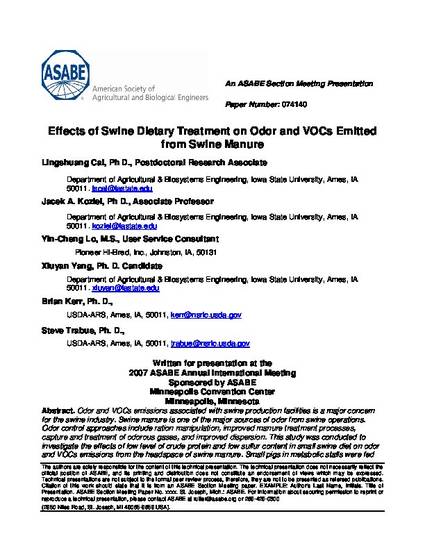
Odor and VOCs emissions associated with swine production facilities is a major concern for the swine industry. Swine manure is one of the major sources of odor from swine operations. Odor control approaches include ration manipulation, improved manure treatment processes, capture and treatment of odorous gases, and improved dispersion. This study was conducted to investigate the effects of low level of crude protein and low sulfur content in small swine diet on odor and VOCs emissions from the headspace of swine manure. Small pigs in metabolic stalls were fed twice daily over 28 days with diets containing either 19.36 % crude protein, 7.06 % cellulose and 2,296 mg/kg sulfur (diet B) or 17.83 % crude protein, 6.82 % cellulose and 1,772 mg/kg sulfur (diet H). Three replicate trials were conducted and three pigs were used for each diet. All excreted manure (feces and urine) were collected daily after morning feeding and added to the manure storage vessel designed to hold waste from the same growing pig. Gas samples were collected from the headspace of manure storage container using 85 µm Carboxen/PDMS SPME fibers at the end of each trial and three replicate gas samples were collected for each pig. All samples were analyzed simultaneously for chemicals and odors on a GC-MS-olfactometry system. Statistical analyses were performed to determine the effects on diets on target odorous chemicals and odor. A total of 40 compounds belonging to 14 chemical classes were identified the headspace of swine manure. A subset of 14 odorous compounds responsible for the characteristic odor of swine manure odor were selected for statistical analyses. Lower sulfur and lower crude protein diet was associated with reduced methanethiol (p=0.0686), dimethyl sulfide (p=0.0006), 2,4-dithiapentane (p2S) (p=0.0014), 'acetic' (acetic acid) (p=0.00001), 'skunky' (2,4-dithiapentane) (p=0.0261), 'onion' (dimethyl trisulfide) (p=0.0122) and phenolic' (4-ethyl phenol) (p=0.0168).
Available at: http://works.bepress.com/jacek_koziel/17/

This is an ASABE Meeting Presentation, Paper No. 074140.